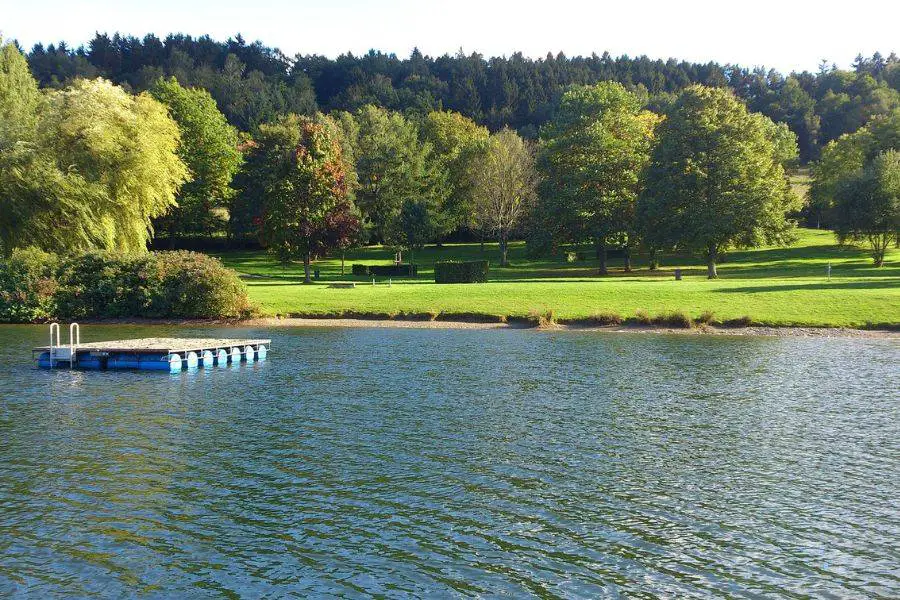Table of Contents
If you have basic construction skills or maybe a few handy pals, you, too, can build a floating dock with PVC pipe just like this one. Let’s begin.
A floating dock is a must-have if you own a home by the lake or the river.
With a floating dock system in place, you are provided with a convenient platform to dock your boat.

Or if you need a place to simply relax by the water.
Durability, however, is a key issue when building a platform that will rest on a water surface.
You will need to ensure that it is built with utmost precision and perfection.
To help you get started, this article provides a step-by-step guide on how to build a floating dock system with PVC.
Why PVC?
Several marine-grade materials are suitable for building a floating dock system, from composite wood material to pressure-treated lumber to concrete.
However, PVC is most widely regarded due to its low maintenance, lightweight, and cost-effective qualities.
When PVC is capped on both open ends, it will comfortably float on water.
Since this is a DIY project, PVC is the perfect material to get started.
A Few Benefits of Building a Floating Dock
- A floating dock, depending on its construction, can adapt to several water conditions. So, you can rest assured if the water level changes or the water pressure around the lake fluctuates. A floating dock is built to withstand actions like these.
- It can be done with little supervision and expert knowledge in construction is not necessarily required. Although, it is recommended to seek thorough consultation from experienced construction personnel. It is better to have professionals with you on the project.
- It is cost-effective and relatively inexpensive to build
- The installation is straightforward and quick with little technicality required.
- It is versatile and can change from a permanent structure (using poles or stilts) to a temporary floating platform during construction.
Things to Consider Before You Start Building Your Floating Dock
There are a few questions you must first answer before you begin work on your project.
1. How do you intend to use your floating dock?
Do you want a platform where you can sit by the lake in the evening and gaze into the beautiful sunset?
Or do you intend to build a place strong enough to dock your boat for long periods?
These are considerations that will determine the strength and durability of your project.
2. What will be the size of your floating dock?
You must determine the dimensions of the platform like the length, breadth, and width.
Write the measurements down on a piece of paper.
Materials you will need:
- 10-foot lengths of PVC pipe
- PVC end caps
- PVC glue and primer
- 10-foot lengths of 2×6 pressure-treated wood
- Nylon straps
- Power drill
A Step-By-Step Guide to Building a Floating Dock With PVC Pipe
Step 1: Construct the Frame
After determining the size of your floating dock, use the measurement to calculate the number of PVC pipes you will need.
Then construct the frame by screwing the two-by-six boards together into a square or rectangle pattern depending on the measurements gotten.
By multiplying the number of PVC pipes you need by two, you will get the total number of PVC end caps needed to cover the pipes.

Step 2: Fastening the PVC Pipes Together
On the outside rim of the PVC pipes and the inside boundary of the PVC end caps, apply little amounts of PVC primer.
Then apply the PVC glue on the inside of the PVC end cap and repeat the same with the outer top surface of the PVC pipes.
Fix the end caps on top of the pipes and allow 30 seconds for the glue to dry.
Step 3: Place the PVC Floats
Nail the nylon straps to the pressure-treated wood frame and tighten the hermetically sealed PVC pipes to the frame.
Ensure that the PVC pipes are firmly secured to avoid them from coming loose.
The best way to achieve this is to first arrange the PVC pipes very close to each other.
After this is done, it becomes easy to fasten them together and to stay afloat.
Step 4: Secure Your Floating Ramp or Allow It to Float
One of the great things about floating docks is the versatility they can bring to construction.
The difference between floating docks and stationary docks is in the movement.
Stationary platforms are permanent structures.
They sit on piles drilled into the ground and this gives them stability and makes them permanent.
Floating docks give you the variety of having both.
Now, you can flip the ramp over and it is ready to float gloriously on top of the water.
Nevertheless, you can also secure its position to avoid the platform moving all around the place.
First, you’ll need to dig deep holes into the lake bed and attach poles to the four corners of the floating dock.
Then use ropes to fasten the poles to the dock platform and place them into the ground.
This should give your floating dock the required stability to withstand changes in water pressure and the wind.
The dock may then be untied from the poles and allowed to float around the lake.
Building a Floating Dock Concrete Base on Shallow Water
Sometimes, the water bank close to your home may be very shallow but that shouldn’t stop you from building your floating dock.
But you will need to create a concrete deck base. Here’s the lowdown.
Step 1: Prepare the Dock Area
Choosing a level for the base is important for placing the concrete blocks on the ground.
After this, you should begin clearing the ground to ensure it is smooth and clear of rocks or debris.
Step 2: Assembling the Concrete Blocks
When a floating dock is built on concrete blocks above shallow water, it offers stability.
It also functions as a base for your platform to rest comfortably on the water.
Typically, the size of the floating dock you want to build will determine the number of concrete blocks needed to create a solid foundation.
Then you may begin placing the blocks at every corner of the platform and also at horizontal and vertical intervals depending on the size.
In step 1, we spoke about the importance of checking the ground level before laying the blocks.
This will determine the stability of the foundation on level ground.
Conclusion
There are so many benefits to having a floating dock around your home.
And truly, a home by the river or lake is of lesser value if you cannot engage in activities inside or around the water.
This is why floating docks are very popular with houses in this category.
They are convenient, provide great utility, and can be done on a budget.
As a DIY project, a floating dock, even if a little bit challenging, can offer great rewards for any homeowner.
You can customize it over time and easily disassemble it when you no longer require its use.
So, are you ready to build your floating dock with PVC? Let’s get started!








![[Tutorial] How to Build a Bug Out Bag Correctly [Tutorial] How to Build a Bug Out Bag Correctly](https://homesteadandprepper.com/wp-content/uploads/2015/02/disaster.jpg)
